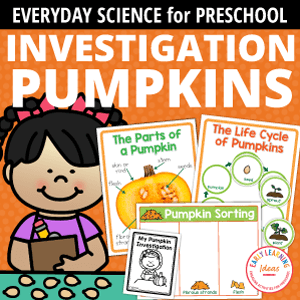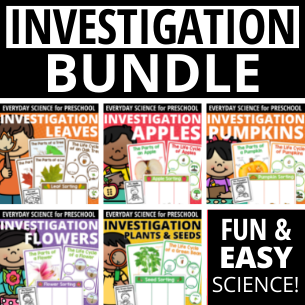The Best Pumpkin Science Activities that will Engage Your Kids
Make science exciting with these pumpkin science ideas. These pumpkin investigation activities are perfect for a Halloween or fall science center in your preschool, pre-k, or kindergarten classroom.
JUST Purchase the printables
No Time to Read The Whole Article?
Here are the quick links to purchase the printables featured in the article.
Are you looking for some engaging science activities to fill your science center this fall? Fall is all about pumpkins (or pumpkin spice), so it only makes sense to fill your science center with these fall plants. Check out these pumpkin science activity ideas perfect for fall or Halloween.
If you search Pinterest, I’m sure that you will find pumpkin science experiments. You may find things like exploding pumpkins or pumpkin slime …things that don’t really have much to do with pumpkin science.
There is so much that you can teach kids about pumpkins! Instead of creating a pumpkin-themed show, let me show you how to teach your kids to conduct a real scientific investigation of pumpkins.
In the process, kids will learn all about the pumpkin life cycle, pumpkin parts, how to measure and record data, and so much more!
The printables pictured in this article are part of my Pumpkins Investigation resource.
Examine the Inside of the Pumpkin
I enjoy carving pumpkins, but when you just cut a little hole at the top of the pumpkin, kids can’t see all of the STUFF inside the cavity.
Speaking of the STUFF…. What do you call the stuff inside the pumpkin? At home, I call the inside of a pumpkin the guts. This is the perfect time to introduce some new knowledge and vocabulary to your kids.
Pumpkin guts, that stringy stuff, are really called the pulp or fibrous strands. The flesh or meat of the pumpkin is between the skin and
Instead of just creating a round opening at the top of a pumpkin, cut a pumpkin in half from the stem end to the blossom end so that your kids can see EVERYTHING inside the pumpkin.
Can they find these parts?
- seeds
- fibrous strands
- flesh
- skin or rind
- stem
- blossom end
Let your children sort the parts of the pumpkin. There is nothing more hands-on then putting grabbing a handful of pumpkin pulp and sorting the seeds from the fibrous strands.
I’m okay with it now, but in the past, I hated touching the slimy pumpkin parts. I’m sure you will have some kids who don’t want to touch the gooey stuff and that’s no problem. Provide some tweezers or small tongs to help kids who don’t want to touch the stuff.
You can also use the seeds for counting activities or in a sensory table. I like how seeds feel in a container of water.
Examine the Outside of The Pumpkin
Scientists examine things to classify them. Your kids can learn to classify pumpkins by:
- color
- texture
- size
- shape
- size
I am amazed by the different varieties of pumpkins that I have seen in stores in recent years. Try to get a variety of different kinds and sizes of pumpkins for kids to check out. Are they surprised to see any of them?
What Color is the Pumpkin?
Encourage kids to pick one of the pumpkins to investigate more thoroughly. What color is the pumpkin? Is it a single color or does it have more than one color? Does it have stripes or lumps? Provide crayons so that your kids can draw pictures of their pumpkins.
What Kind of Texture Does the Pumpkin Have?
What does the outside of the pumpkin feel like? Is it smooth, lumpy, bumpy? Does it have ribs? How many?
Sometimes the stem gets knocked off pumpkins. Does their pumpkin still have a stem attached? Your little scientist can record their observations in their pumpkin investigation journal.
Determine the Size and Shape of the Pumpkin
Is the pumpkin small, medium, or large? Is it wide, tall, or round? If you have lots of pumpkins, encourage your kids to sort them by size or shape.
Sort and Classify Pumpkins by Appearance
If you don’t have lots of real pumpkins for kids to examine, you can use photographs of pumpkins. Encourage your kids to find different ways to sort them. Here are some ideas.
- by color
- bumpy vs. smooth pumpkins
- tall vs. wide pumpkins
- multi-color vs. single color pumpkins
Measure the Pumpkin
Scientists measure and record data. So, if you are doing pumpkin science, you should measure and record data about pumpkins. Kids can measure their pumpkins in several different ways.
There are 4 different ways that your kids can measure their pumpkins.
- weight
- height
- circumference
- density
Measure the Weight
Provide a scale for kids to measure the weight of their pumpkin. If you have small pumpkins, you can measure them on a kitchen scale. If you have large pumpkins, you may have to bring in the big bad bathroom scales. They can record results in a blank book or pumpkin investigation book.
If you have tiny pumpkins, kids will enjoy comparing their weight with a bucket or balance scale. Let them compare the weights to find the heaviest and lightest ones.
Measure the Height
You can measure the height of a pumpkin with a ruler or measuring strip, but counting cubes are also a fun way for kids to measure things.
They can stack the cubes until they are the same height as the pumpkin and then record the number of cubes in their science journal or notebook.
Measure the Circumference
The circumference is the measurement around the pumpkin. Kids can measure with a tape measure or with a string….or both.
Help them cut the string and they can tape it to their investigation book or science journal.
Measure the Density – Sink or Float Experieme
Did you know that the density of something determines whether it sinks or floats? If an object is less dense than water, it will sink. If an object is denser than water it will float. Something that floats is buoyant.
Kids enjoy conducting this little pumpkin science experiment, and they are often surprised by the results.
Add water to a large, clear container. Kids can predict whether their pumpkin will sink or float, and then they can test their hypothesis.
Did they predict correctly? Let them try different pumpkins. Is the result the same?
Learn About the Pumpkin Life-Cycle
Provide books so that kids can see pumpkins at different stages of the pumpkin life cycle. Extend your pumpkin investigation to other times of the year. If you have space, plant some seeds in the spring and watch them develop through the fall.
If you are lucky, you can even be able to take a field trip to a REAL pumpkin patch.
Pumpkin Taste Testing
The Five Senses
Kids can explore pumpkins with all of their senses.
- See – Kids can observe the size, shape, and color of pumpkins. Plus, they can identify the different parts of the fruit.
- Feel -They can feel the cool skin and slimy insides.
- Hear – Ask children to listen closely as they squish the pumpkin pulp with their fingers. Can they hear anything? Encourage kids to knock on pumpkins to hear if they sound differently.
- Smell – If you cut a pumpkin open, the smell will diffuse throughout the room. Does it smell good?
Don’t forget to let kids TASTE pumpkins too!
The Taste Test – Prep
If you have time to bake some fresh pumpkin….go for it. But, it’s super easy to just open a can of pumpkin for sampling. It’s fun to sample pumpkin seeds too. You can roast some fresh pumpkin seeds if you want, or you can get pepitas in the bulk food section of your grocery store. BTW….pepitas are great to have on hand for salads.
I like to control chaos as much as possible, so I like to prep things in advance. You can prep samples in muffin liners…..
….or you can prep samples on small paper plates.
Foods for Tasting
Here is a list of items that you can use for pumpkin taste testing. In addition to canned pumpkin, pumpkin seeds, and pepitas, you can add the following pumpkin baked goods to your sampling menu:
- pie
- donuts
- muffins
- bread
- cake
It’s pretty easy to find a variety of pumpkin baked goods at the grocery store in the fall. You don’t have to spend tons of money because you just need to provide a small taste of each food.
Graph and Analyze Data
Make a graph on a large piece of chart paper and the kids can use dot stickers to record how well they like each pumpkin sample. Count up the totals in each grid and help kids analyze the data. Which type of pumpkin was the favorite? Which was the least favorite? How can you tell?
Pumpkin science can be so much fun. I hope that you and your kids enjoy investigating pumpkins.
Purchase the Printables
Are you ready to get started on some pumpkin science activities with your kids? The Pumpkin Investigation printables that you see pictured here are available in my store. Click on the image below to get yours today.
Do you prefer to shop at Teachers Pay Teachers? You can also purchase the Pumpkin Investigation and Investigation Bundle in my TPT Store.



















